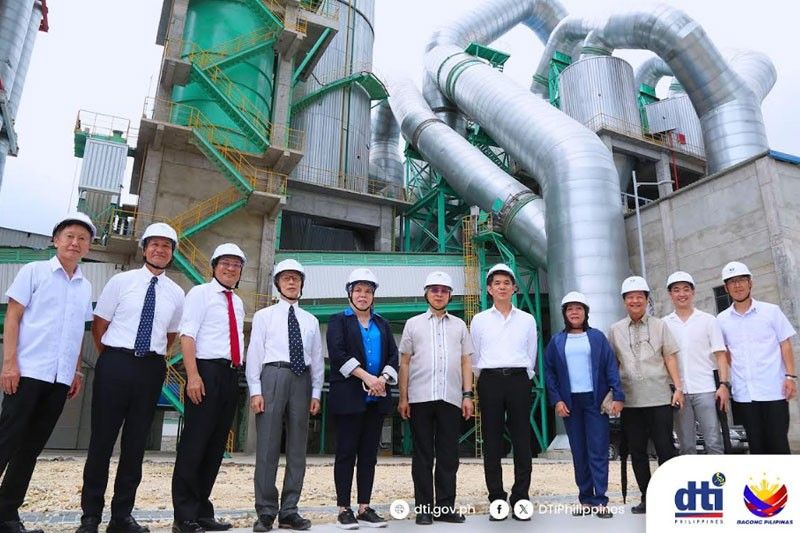P12.8B facility augments Cebu cement production

CEBU, Philippines — Cebu now produces 100,000 more bags of cement per day after a local maker replaced its old production line with a new P12.8 billion state-of-the-art energy-efficient manufacturing facility.
Taiheiyo Cement Philippines, Inc. (TCPI) inaugurated its new plant in San Fernando, Cebu a few days ago. This will help increase its Philippine market share from pre-pandemic seven percent to 10 percent by 2025.
TCPI used to produce only 50,000 to 65,000 bags of cement per day and will now produce no less than 150,000 bags per day, an increase from daily clinker production of 2,500 tons to 6,000 tons, shares the company.
The inauguration of the new facility comes on the heels of the country’s construction industry, which has started to recover after the pandemic, fueled by the national government's Build Better More (BBM) infrastructure program.
Masafumi Fushihara, chairman of TCPI’s mother company Taiheiyo Cement Corp. (TCC) of Japan, and Yoshufumi Taura, president and representative director, joined TCPI president and CEO Takashi Miyashita and other executives to mark the milestone.
Taura acknowledged that TCC has shifted focus with its investments towards Southeast Asia, especially in the country.
“We have identified the Philippines as (having) an exceptionally attractive investment environment with its remarkable economic laws, driven by cooperation, expansion and ambitious infrastructure investment,” he said adding that the company aims to contribute to the economic development of the Philippines by providing a stable supply of high-quality cement for infrastructure investment.
Also now operating in San Fernando town is a jetty and a new marine belt conveyor system that runs from an expanded port offshore, complementing the new plant.
Taura said Taiheiyo has been diligently working towards the objective of becoming a corporate group that prioritizes safety and security for society across the Pacific rim, “leveraging the collective strength of our group.”
He said the new TCPI production line is a "state-of-the-art, energy-efficient facility producing quality clinker that will enable us to reduce our clinker intensity, and thereby our CO2 emission.”
Miyashita recalled that TCC approved the investment as its board “firmly believes in the Philippines' capacity to sustain remarkable growth.”
He said the new plant can produce up to five million metric tons per year, yet “our efforts are devoted to reducing carbon footprints through improving energy efficiency.”
“This commitment aligns with the Sustainable Development Goals (SDGs) for energy and environment which are the shared objectives of countries around the globe,” he pointed out.
Meanwhile, DTI secretary Alfredo Pascual declared the production capacity of the new TCPI plant “will reduce our reliance on imports” and “aligns perfectly” with the government's.
“This will further propel the country's economic growth and development,” he said, noting that the new plant “will bolster the Philippine cement production by three million tons annually.”
Pascual commended TCPI “for setting a new standard for environmentally responsible manufacturing in the cement industry,” pointing out that the new plant will “reduce carbon dioxide emissions by at least 10 percent.”
It would mean a decrease in energy consumption and a lower clinker factor that “contributes to achieving a greater and greener future for our world.”
Other than the P12.8 billion plant, he cited the P3.1 billion jetty and marine belt conveyor project, the P1.4 billion port area development also in San Fernando, and the P3.7 billion Luzon distribution terminal in Calaca, Batangas.
Pascual said Japan's continued development and assistance propelled the Philippines to achieve a remarkable growth in gross domestic product (GDP) of 5.6 percent last year 2023, outperforming major Asian economies.
He noted that the International Monetary Fund (IMF) and the Asian Development Bank (ADB) forecast a six percent GDP growth rate this year 2024, and 6.2 percent in 2025, “again the fastest in Southeast Asia.”
He said the government seeks to sustain annual public infrastructure spending at five to six percent of GDP under the BBM infrastructure program.
“This level of spending for infrastructure will keep the high demand for local cement,” he pointed out.
“I urge Taiheiyo to sustain its investment commitment in the Philippines. Together, we will continue to build a more robust and dynamic construction sector in the country, driving economic growth, providing jobs, and improving the lives of Filipinos,” he added.
Along with Pascual, Gov. Gwendolyn F. Garcia witnessed the inauguration with Secretary Frederick D. Go, special assistant for investment and economic affairs of President Bongbong Marcos who he represented, and Japanese Ambassador to the Philippines Endo Kazuya. — (FREEMAN)
- Latest
























